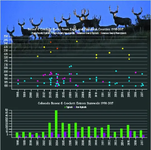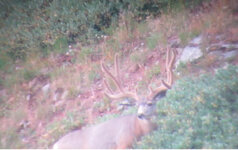idelkslayer
WKR
- Joined
- Jan 17, 2013
- Location
- Idaho
Holy cow, this is the longest post I’ve ever created but there are a lot of parts and pieces to bring together for a complete idea to be communicated.
Mule deer management has always been a popular topic and the subject of many threads. Restricted weapons seasons (replacing modern scoped rifle seasons with muzzleloader or non-scoped rifle seasons) have emerged as the latest catalyst for discussion. It makes me think about what the desired outcome is for hunters and will restricted weapons seasons have that desired effect. In the midst of these discussion Idaho Fish and Game has released the latest in a series of videos about mule deer management and I found it to contain some very interesting points.
Idaho Fish and Game (IDFG) has put together an excellent series of videos over the last year that walk through how they approach mule deer management. One of the most recent videos linked below, deals with trophy management for mule deer. This video pulls together information from Montana, Idaho, Utah, and Colorado. It contained some information that was new and surprising to me and might impact how you view any future trophy management discussion.
I highly recommend that you watch the entire video. This post is already overly long and to save space I won’t copy the charts in this post, but I will cite several time stamps in the video so that you can go to the charts and listen to the biologists explanation.
First, IDFG defines trophy management as management for increased buck:doe (B : D) ratios, older age classes, and increased proportion of mature or trophy individuals in the harvest. Trophy management is typically achieved through one of two strategies. First, is reduction of hunter numbers. Second, is reduction in hunter success rates.
The current proposal for restricted weapons is an attempt at employing the second strategy but might also have an indirect impact on the first through hunters voluntarily choosing to leave restricted units and hunt elsewhere.
Mule deer management has always been a popular topic and the subject of many threads. Restricted weapons seasons (replacing modern scoped rifle seasons with muzzleloader or non-scoped rifle seasons) have emerged as the latest catalyst for discussion. It makes me think about what the desired outcome is for hunters and will restricted weapons seasons have that desired effect. In the midst of these discussion Idaho Fish and Game has released the latest in a series of videos about mule deer management and I found it to contain some very interesting points.
Idaho Fish and Game (IDFG) has put together an excellent series of videos over the last year that walk through how they approach mule deer management. One of the most recent videos linked below, deals with trophy management for mule deer. This video pulls together information from Montana, Idaho, Utah, and Colorado. It contained some information that was new and surprising to me and might impact how you view any future trophy management discussion.
I highly recommend that you watch the entire video. This post is already overly long and to save space I won’t copy the charts in this post, but I will cite several time stamps in the video so that you can go to the charts and listen to the biologists explanation.
First, IDFG defines trophy management as management for increased buck:doe (B : D) ratios, older age classes, and increased proportion of mature or trophy individuals in the harvest. Trophy management is typically achieved through one of two strategies. First, is reduction of hunter numbers. Second, is reduction in hunter success rates.
The current proposal for restricted weapons is an attempt at employing the second strategy but might also have an indirect impact on the first through hunters voluntarily choosing to leave restricted units and hunt elsewhere.


